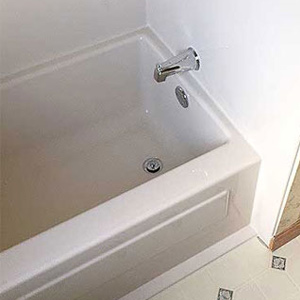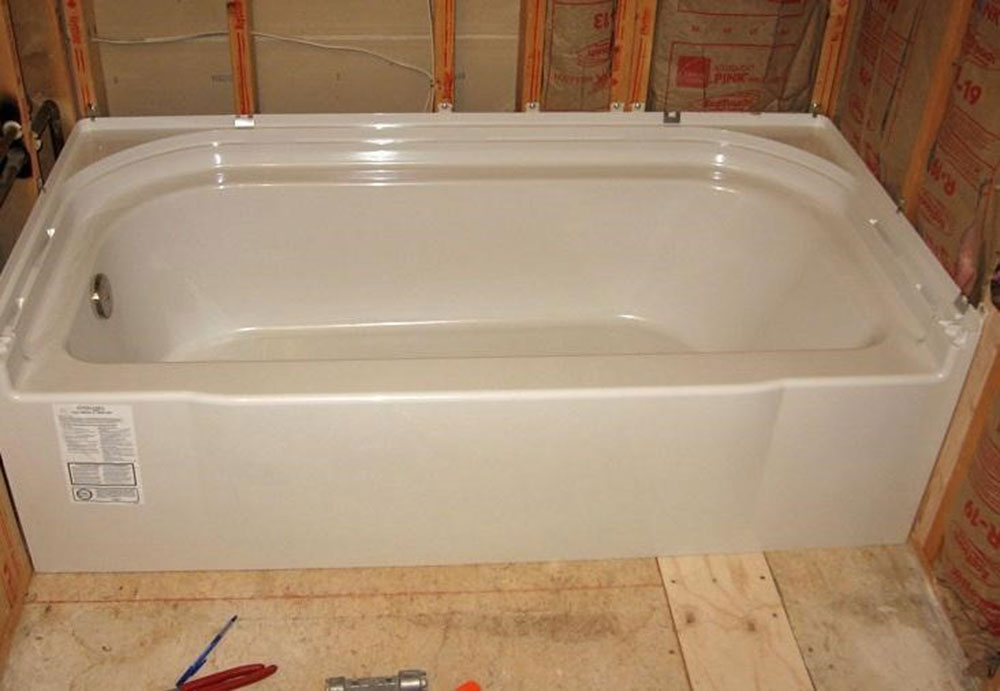The Foundation of Plumbing Knowledge for Bathtub Installation
The Foundation of Plumbing Knowledge for Bathtub Installation
Blog Article
Everybody will have their own unique thinking about How to Install a Bathtub.

Setting up a tub isn't precisely rocket science, however it does require strong plumbing, carpentry, as well as in some cases, tiling abilities. Replacing an old bathtub with a brand-new one is likewise a reasonably difficult project. If the old bathtub is readily easily accessible, the job can move quickly; if you have to open up a wall surface to remove the old bathtub and place the new bathtub, the job is much harder. In either situation, the project is within a house handyman's abilities, although you will certainly require a helper to leave the old bathtub and embeded in the new one. Ensure you have certified on your own for the task and fit trying it. As opposed to hiring a contractor to take over a halfway-completed job, it is far better to consider employing one prior to you begin. Chances are you might need an expert plumber to make tube connections.
This article will help you mount a brand-new bath tub in your restroom if you have already bought a new tub and do not require to alter the arrangement of your previous supply of water pipes.
Your devices and also material list ought to comprise the following:
Removing Old Touches
If you need to change old taps with brand-new ones as a part of your installation, after that the first thing you should do is detach the water supply. After doing so, switch on the taps to drain any kind of water continuing to be in the system. The procedure of removing the existing faucets can be fairly troublesome as a result of the restricted accessibility that is often the instance.
Make use of a basin wrench (crowsfoot spanner) or a tap device to undo the nut that links the supply pipelines to the faucets. Have a towel prepared for the staying water that will certainly come from the pipes. Once the supply pipes have been gotten rid of, make use of the very same tool to loosen the nut that holds the taps onto the bath/basin. You will require to quit the single faucets from transforming throughout this process. When the taps have actually been gotten rid of, the holes in the bath/basin will certainly have to be cleansed of any type of old sealing substance.
Before going on to fit the new taps, contrast the pipe links on the old faucets to the brand-new taps. If the old taps are longer than the new taps, after that a shank adapter is needed for the brand-new taps to fit.
Fitting New Taps
If the tails of the new faucets are plastic, after that you will certainly need a plastic connector to stop damages to the string. One end of the port fits on the plastic tail of the tap and also the various other end supplies a connection to the existent supply pipelines.
If you require to fit a monobloc, then you will certainly need reducing couplers, which attaches the 10mm pipe of the monobloc to the basic 15mm supply pipeline.
Next, place the faucet in the mounting opening in the bath/basin ensuring that the washing machines are in area between the faucet and also the sink. Protect the faucet in place with the maker provided backnut. When the faucet is firmly in place, the supply pipelines can be connected to the tails of the taps. The faucets can either be connected by using corrugated copper piping or with typical faucet connectors. The former type must be attached to the faucet ends first, tightening only by hand. The supply pipes can later be attached to the other end. Tighten both ends with a spanner after both ends have been connected.
Installing the Bathtub
Using the two wooden boards under its feet, position the bath tub in the required position. The wooden boards are practical in uniformly spreading the weight of the bathtub over the area of the boards as opposed to concentrating all the weight onto 4 little factors.
The following goal is to guarantee that the bath tub is leveled all round. This can be attained by inspecting the level as well as adjusting the feet on the bath tub up until the level reviews level.
To install taps, fit all-time low of the furthest adaptable tap adapter to the suitable supply pipeline by making a compression join; after that do the same for the various other faucet.
Activate the water system and check all joints and new pipework for leaks and tighten them if needed. Load the bathtub as well as also check the overflow electrical outlet and the normal outlet for leakages.
Ultimately, repair the bath paneling as explained in the supplier's instruction manual. Tiling and sealing around the bath tub needs to wait until the bathtub has been used at least when as this will settle it right into its last placement.
Planning for the Setup
First of all, the supporting structure supplied with the bath needs to be fitted (if needed) according to the producer's guidelines. Next, fit the faucets or mixer to the bathtub. When fitting the faucet block, it is very important to ensure that if the faucet comes with a plastic washing machine, it is fitted between the bathroom and also the taps. On a plastic bath, it is likewise reasonable to fit a supporting plate under the faucets unit to prevent stress on the tub.
Fit the versatile tap connectors to the bottom of both taps making use of 2 nuts and olives (often supplied with the tub). Fit the plug-hole outlet by smearing mastic filler round the sink outlet hole, and then pass the outlet with the hole in the bathroom. Make use of the nut supplied by the maker to fit the plug-hole. Examine the plug-hole electrical outlet for an inlet on the side for the overflow pipe.
Next, fit the end of the adaptable overflow pipe to the overflow outlet. Afterwards, screw the pipe to the overflow face which must be fitted inside the bathroom. Ensure you utilize all of the provided washing machines.
Attach the trap to the bottom of the waste electrical outlet on the bathtub by winding the thread of the waste outlet with silicone mastic or PTFE tape, and screw on the catch to the electrical outlet. Link the bottom of the overflow tube in a similar manner.The bathroom should currently be ready to be fitted in its final setting.
Tiling Around the Tub
In the location where the bath fulfills the floor tile, it is required to secure the joins with a silicone rubber caulking. This is essential as the fitting can move enough to fracture an inflexible seal, creating the water to permeate the wall surface in between the bathroom and also the tiling, resulting in issues with dampness as well as possible leaks to the ceiling below.
You can pick from a range of coloured sealants to blend in your fixtures and also installations. They are marketed in tubes and cartridges, and also are capable of sealing gaps as much as a size of 3mm (1/8 inch). If you have a larger gap to fill, you can fill it with spins of drenched paper or soft rope. Remember to constantly fill the bath tub with water prior to sealing, to allow for the motion experienced when the tub is in use. The sealer can break rather early if you do not think about this activity before sealing.
Additionally, ceramic coving or quadrant floor tiles can be used to border the bath or shower tray. Plastic strips of coving, which are easy to use and also reduce to dimension, are likewise conveniently readily available on the market. It is a good idea to fit the floor tiles using water-resistant or water-proof adhesive and grout.
Bathtub Installation
How Important Is A Bathtub To Your Home?
High-quality baths, showers, and other bathroom updates are necessary when considering a smart investment in your home. It’s a room that you go to every day and one that is constantly being used by guests.The bathroom is one of the top trafficked rooms in a home and also one of the most valuable in terms of home resale.
Install Piping Before Tub
You will be using your existing drain and waste vent system, but pipes required include the hot and cold water supply lines and a pipe leading to a shower head. A mixing valve and shower head are also needed. Air chambers may be required.
Position the Tub
Lower the tub into place so that the continuous flange fits against the wall studs and rests on 1’x4' or 2’x4' supports. Anchor the tub to the enclosure with nails or screws inserted through the flanges into the studs.
NOTE: Remember, bathtubs and shower stalls may require support framing. A bathtub filled with water is extremely heavy, so check building codes and framing support before installing the tub.
Assemble Drain Connections
Assemble the bathtub drain connections by connecting the tub overflow with the tub drain above the trap, not beyond it. The trap will have a compression fitting that screws over the arm of the overflow assembly.
Place a Pipe For the Shower Head
First, locate a brass female threaded winged fitting and attach it to a framing support via a screw or a nail. Then run a pipe up the wall for the shower head. Sweat or solder the other side of the brass fitting to the top of the pipe.
Attaching Hot and Cold Water Lines
Attach your water lines for both hot and cold by sweating these directly into the hot and cold ports of the mixing valve. The mixing valve will be how water enters the tub’s system, not by the pipes themselves.
Install the Spout
Extend a piece of 1/2 inch pipe, or whichever length is specified in the manufacturer’s instructions, for the tub spout. Sweat on a male threaded fitting at the end of the pipe or use a brass nipple of the proper length and a 1/2 inch cap.
NOTE: At this point you should have your rough-in plumbing work inspected before proceeding further.
Check For Leaks
Restore the water pressure and check the drain connection and the supply pipes for any sign of leaking.
estore the Bathroom Wall
Replace the wall with moisture-resistant drywall as a base for your wall covering. Seal the joints between the wall and your new tub with silicone caulk as protection against water seepage.
https://www.berkeys.com/2016/12/02/bathtub-installation-dallas/

I have been very focused on How to Install a Bathtub Yourself and I really hope you enjoyed reading the entire page. Sharing is nice. One never knows, you may very well be doing someone a favor. I enjoy reading our article about How to Install a Bathtub Yourself.
Immediate attention? Phone us! Report this page